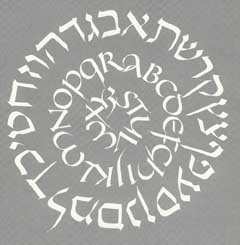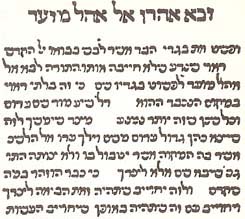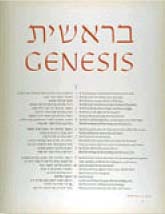 About 15 years ago I was relatively new to Hebrew type. A local friend, Briem, suggested that I contact someone he knew in New York who was a wonderful calligrapher, and had even contributed a page to his book, "60 Alphabets".
About 15 years ago I was relatively new to Hebrew type. A local friend, Briem, suggested that I contact someone he knew in New York who was a wonderful calligrapher, and had even contributed a page to his book, "60 Alphabets".
Little did I know.
So, prior to my next trip to New York, I contacted Ms. Wronker, who suggested that we meet at the New York Public Library, which was then doing an exhibit on Hebrew ("A Sign and a Witness: 2000 Years of Hebrew Books and Illuminated Manuscripts"). We met. She was a lively person, somewhat past middle-aged, but not remotely old. And, in the hour we spent going through the New York Public Library Exhibit I learned my about Hebrew lettering that I have learned before or since. From micrography to the latest types, Lili could point out the salient points, give them context and description, and quickly move me on, the better to finish up and go back to her place for lunch and an afternoon of book study. This was the sort of place in which Lili and Erich, her husband, even kept a small letterpress in their bedroom.
Lili is still my teacher, although I would also claim that we are also friends. This past week I dropped by to catch up, to tell her about my forthcoming KlezKanada lecture and see the video she has made of her basic "this is Hebrew lettering" lecture. As usual, I left with too damn many good ideas to incorporate at this stage, but also inspired.
 For instance, she reminded me that Francesco Griffo, known to most folks as Aldus Manutius' punchcutter, also cut the first type for the great Italian printer, Gerson Soncino. Aldus was not pleased that Griffo was working with Soncino and kept non-Hebrew commissions from him. Think, too, of Estellina Conat, wife of Rabbi Abraham Conat. The Rabbi was perhaps the first Hebrew printer in Italy, succeeding in printing six books between 1476 to 1480:
For instance, she reminded me that Francesco Griffo, known to most folks as Aldus Manutius' punchcutter, also cut the first type for the great Italian printer, Gerson Soncino. Aldus was not pleased that Griffo was working with Soncino and kept non-Hebrew commissions from him. Think, too, of Estellina Conat, wife of Rabbi Abraham Conat. The Rabbi was perhaps the first Hebrew printer in Italy, succeeding in printing six books between 1476 to 1480:
The legal code, 'Path of Life' the traveler's tales of Eldad the Danite, the popular version of Josephus, Rabbi Levi ben Gerson's commentary on the Pentateuch, an astronimcal table by Mordecai Finzi and 'The Drippings of the Honeycomb' by Rabbi Judah ben Yehiel, the first Hebrew book published in the lifetime of its author. (from "Makers of Hebrew Books in Italy," David W. Amram, Holland Press:London, 1963)
But here is what is notable. Already with the introduction of Hebrew printing, the good Rebitzen printed a book on her own account ("Investigation of the World," by Jedaiah Bedersi), so that Hebrew printing in Italy was introduced not just by a man, but by both man and woman. Consider that Jewish tradition bars women from writing Torah scrolls and the significance of this partnership in printing Hebrew books becomes even more significant.
She 'wrote' the book, as her husband said, 'with many pens without the aid of miracle,' for the art had not yet invented the word 'printing' (dfus, דפוס ), a term invented by Abraham the Dyer, in 1477, at Ferrara (source: Amram).
 From a sample in her video, I was introduced to an incredible handwriting/calligraphy manual by Israeli calligrapher Noah Ophir, and the late Leila Avrin (whose article in Fine Print 12:1, January 1986, "Acrophonic, Micrographic, Typographic: The Story of Hebrew Letters," is, like her entries on Hebrew Typography in the Encyclopedia Judaica, definitive, wonderfully-illustrated, and clear) that I must purchase asap. Ophir has also done some amazing work with a calligraphy hand based on the same hand used in the Dead Sea Scrolls. Lili also pointed out a plate that has been framed on her wall for years, of a page of Genesis set by the late Ismar David. That it is beautiful goes without saying. It was part of a collection of 42 pages done by the best typographers of the age: Joseph Blumenthal, D. Stempal, Hermann Zapf, Jan Van Krimpen, Joh. Enschede en Zonen, Jan Tschichold, Bruce Rogers, ... in which each solve a typographic problem in setting the bible. Lili's daughter has promised to send me a scan of the print. What is notable, aside from the use of David's eponymous Hebrew face, is that it is also an impeccable example of the beauty of (in my never humble opinion) correct placement of the Hebrew on the left-hand side of the page, starting from a slightly off-set center, and the English on the right-hand side, again, starting slightly off-center (the same text set in both languages will not take up an equal amount of space - the Hebrew line will always average a bit shorter than the English; even moreso if it is Hebrew w/translation - so the designer has to pay attention to the texts and translations of a given work and adjust accordingly). Note the use of the line numbers to pull the Hebrew and English even more closely together. Now, if I can just convince more Hebrew book publishers to follow suit and end the tyranny of dueling alphabets, facing each other, as if in hostility, from opposing farthest reaches of the spread or page.
From a sample in her video, I was introduced to an incredible handwriting/calligraphy manual by Israeli calligrapher Noah Ophir, and the late Leila Avrin (whose article in Fine Print 12:1, January 1986, "Acrophonic, Micrographic, Typographic: The Story of Hebrew Letters," is, like her entries on Hebrew Typography in the Encyclopedia Judaica, definitive, wonderfully-illustrated, and clear) that I must purchase asap. Ophir has also done some amazing work with a calligraphy hand based on the same hand used in the Dead Sea Scrolls. Lili also pointed out a plate that has been framed on her wall for years, of a page of Genesis set by the late Ismar David. That it is beautiful goes without saying. It was part of a collection of 42 pages done by the best typographers of the age: Joseph Blumenthal, D. Stempal, Hermann Zapf, Jan Van Krimpen, Joh. Enschede en Zonen, Jan Tschichold, Bruce Rogers, ... in which each solve a typographic problem in setting the bible. Lili's daughter has promised to send me a scan of the print. What is notable, aside from the use of David's eponymous Hebrew face, is that it is also an impeccable example of the beauty of (in my never humble opinion) correct placement of the Hebrew on the left-hand side of the page, starting from a slightly off-set center, and the English on the right-hand side, again, starting slightly off-center (the same text set in both languages will not take up an equal amount of space - the Hebrew line will always average a bit shorter than the English; even moreso if it is Hebrew w/translation - so the designer has to pay attention to the texts and translations of a given work and adjust accordingly). Note the use of the line numbers to pull the Hebrew and English even more closely together. Now, if I can just convince more Hebrew book publishers to follow suit and end the tyranny of dueling alphabets, facing each other, as if in hostility, from opposing farthest reaches of the spread or page.
Getting back to the video, Lili notes that writing (amazing illustrations - I hope that she is persuaded to make it available for general purchase) was invented by the Phoenicians around 1700 BCE (did I write this down correctly?). There were 27 characters. By the time the Hebrews conquered Canaan and inherited the writing system, the number was down to 22 letters.
In Jewish tradition, Hebrew letters are considered sacred, and writing with the name of God cannot be thrown away. It must be buried or stored forever in a room known as a "genizah". This has been a blessing, in a way, because one instance of a genizah, in Cairo, explored by Solomon Schaecter, produced a treasure trove not just of writing samples going back hundreds of years, but actual letters in the hands of such luminaries as Maimonides.
Finally, Matthew Carter, one of the pre-eminent typographers of our age, has designed a Hebrew typeface. I must find time tomorrow, or soon, to call the Carter Cone studios and ask after it. If the font isn't available, perhaps I can get some proofs of the Bible it was used to set for my lectures.
Days spent working with Hebrew, or just in discussing it, are so full and so rich. By me, it is davenning. Sorry for rambling - blame it all on Lili, still an amazing ball of energy and an amazing calligrapher.
